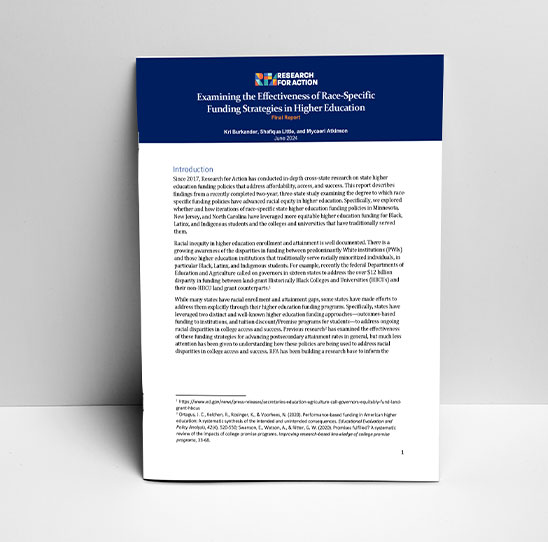Overview
Understanding the Issue:
Why Leveraging OBF for Equity is Important
The Challenge: Can OBF increase equity?
Outcomes-based funding (OBF) policies are a common approach to distributing state dollars to public colleges and universities. Outcomes-based funding is based on a theory about how three important elements of the postsecondary landscape work together. First, states construct policies that provide financial rewards to institutions to improve outcomes that are important to the state, such as increasing college completion. Second, institutions respond to these incentives by adjusting their policies and practices to achieve the outcomes identified in a policy. Third, these shifts in state policy and institutional practice are designed to improve student outcomes. If OBF works as designed, state dollars and institutional practices work together to create an environment that is focused on increasing the number and percentage of students who succeed in college.
OBF is a prominent and continuing part of the state postsecondary policy landscape. As of FY2018, about 30 states have adopted some form of OBF, and hundreds of millions of dollars are now driven out to colleges and universities via these policies. In short, OBF has enormous potential to affect both students and the institutions that serve them.
However, there are legitimate and serious concerns about the extent to which these policies support or frustrate efforts to close attainment gaps, particularly for low-income students and students of color. These concerns extend to the effect OBF policies may have on institutions that enroll large numbers of underserved students or institutions that have been historically or systematically under-funded.
What does equity mean in the context of OBF policies?
Simply put, equity-focused OBF policy should be designed to improve outcomes for underserved students and close persistent gaps in postsecondary access, retention and attainment. But the process of achieving these goals involves the complex interplay of equity at three distinct levels—students, institutions, and states/systems. For equity to increase under OBF, there must be an equity focus for each level. Our definition of equity in the context of OBF is provided below.
Equity for Students. All students, regardless of their racial, ethnic, or socioeconomic background, must have equitable access to quality postsecondary education and the resources they need to succeed once they enroll. For equity to be realized in U.S. higher education, students that have historically been left behind, particularly students of color and low-income students, must receive targeted support and interventions on their path to degree attainment.
OBF policies provide fiscal rewards to institutions when all students increase their persistence and completion. However, to address equity, OBF policies can also incentivize and reward the success of student groups recognized as underserved by a state, such as low-income or rural students, students of color, or other students facing attainment gaps in the state.
Equity across Institutions. To achieve equitable outcomes for students, institutions need adequate resources, deployed effectively, to improve outcomes for underserved students. However, the resource gap between institutions in a single state is often wide. In addition, variation in mission and student populations further exacerbates an uneven playing field, as more resources are needed to ensure that historically underserved students succeed.
OBF policies incent institutions to adjust policies and practices to increase student outcomes. Equitable OBF policy can help ensure that all institutions have the resources and supports they need to serve their students, so that they can reasonably be held accountable for their students’ success.
State or System Policies that Advance Equity. Postsecondary policymakers have an obligation to design and implement policy that promotes equity for students and across institutions.
OBF policies identify outcomes that are important to the state, such as increasing college completion. A policy that advances equity will consider outcomes for underserved students and the overall success of under-resources institutions as well. Policies that advance equity will balance a focus on student outcomes with providing:
- Extra incentives and rewards for institutions to increase outcomes for historically underserved student populations;
- Adequate resources and support for institutions so that they can be expected to increase student outcomes; and
- Flexibility in performance measures to recognize variation in institutional mission and student demographics.
The Toolkit
About this OBF Equity Toolkit
The OBF Equity Toolkit provides practical lessons on how states, systems, and institutions work to address equity in the development and implementation of OBF policy. Broken into four Series focused on equity challenges in distinct phases of the OBF policy process, the Toolkit contains short, individual modules that focus on specific topics and provide lessons learned and recommendations for policymakers and institutional leaders to consider. Content is derived from in-depth study of six states (Tennessee, Indiana, Louisiana, Ohio, New Mexico, Oregon, Kentucky, and Washington) and 13 institutions in them. See the Research Methods section of the Overview for more information.
Download the Toolkit
The OBF Equity Toolkit captures the challenges and opportunities inherent in these efforts. Download the full Toolkit.
Download
Series 1
Background: Leveraging OBF for Equity
Series 1 provides detailed information on each state’s OBF policy, including each state’s equity challenge, important state context, the process for development and refinement, and equity metrics.
Download the Whole Series
Series 2
OBF Policy Development and Redesign: Prioritizing Equity
Series 2 provides examples of how states and institutions approached the process of creating and refining OBF policies that prioritize increased outcomes for underserved student populations.
Download the Whole SeriesModules
- 2.1 Case Study of Oregon: Integrating Equity in Formula Design
- 2.2 Involving Institutions in OBF Policy Development
- 2.3 Selecting Student Groups to Prioritize in OBF Policies
- 2.4 Equity Metrics: How States Construct OBF Formulas to Improve Outcomes for Underserved Students
- 2.5 Involving Institutions in OBF Policy Review and Revision
- 2.6 Increasing Completions Through Quality Certificates
- 2.7 Recognizing Institutional Mission
- 2.8 Louisiana and Washington Using OBF/SSF to Increase Racial Equity

Series 3
OBF Implementation: State Strategies for Supporting Institutions to Close Equity Gaps
Series 3 details a range of strategies that states used during the OBF implementation process to identify and address inequities between institutions.
Download the Whole SeriesModules
- 3.1 Identifying the Capacity Needs of Disadvantaged Institutions to Increase Outcomes Under OBF
- 3.2 Strategies for Supporting Institutions During OBF Implementation
- 3.3 Constructing OBF Policies that Consider Small Schools
- 3.4 Case Study of Tennessee: Advancing OBF Equity Through a State Completion Agenda

Series 4
Institutional Response: Improving Performance and the Success of Underserved Students with OBF
Series 4 provides examples of how institutions responded to OBF while prioritizing equitable student outcomes.
Download the Whole SeriesModules
- 4.1 Case Study of Central New Mexico Community College: Responding to OBF Policy without Leaving Students Behind
- 4.2 Institutional Checklist for Effective Response
- 4.3 Case Study of Western Oregon University: Shifting Directions to Improve Equity
- 4.4 Institutional Response by Administrative Position

Series 5
Student Success Funding Strategies to Increase Racial and Socioeconomic Equity
Section 5 provides examples of how states and institutions approached leveraging SSF and OBF strategies to increase racial equity during the time of COVID-19.
Voices from the Field
Research Methods
RFA partnered with the Center for Law and Social Policy during the 2017-2018 academic year to conduct mixed-methods research in six states engaged in equity-focused OBF policy. We conducted multi-day site visits to each state and talked to a wide array of policymakers involved in OBF. We also selected 2-3 institutions in each state to visit as well. Throughout the course of our data collection and analysis, we examined an array of documents related to OBF, and developed detailed state policy profiles to ensure that we had a full understanding of context prior to our site visits.
Data Sources
Findings are drawn from interviews with 141 policymakers and institutional leaders across 13 institutions in six states. In addition, our analysis also includes a thorough document analysis of legislation, descriptions of policy, meeting minutes, power point presentations, and state- and system-level planning documents.
State Sample
Our study states include Tennessee, Indiana, New Mexico, Oregon, Ohio, and Kentucky. Study states were selected because they provide variation along several important dimensions:
- Phase of OBF development and implementation
- Sectors in which OBF is implemented;
- Approaches to equity metrics and weights;
- Racial, ethnic and geographical diversity; and
- Degree of political support and stakeholder involvement.
In each state, interviews were conducted with policymakers, primarily state and system postsecondary leaders and staff. Twenty-six policymakers across six states were interviewed.
Institutional Selection
Interviews were conducted at 13 institutions across the state sample (2 to 3 institutions per state). Institutions were selected in both the two- and four-year sectors and across variety of institutional missions. Selected institutions typically serve a high percentage of low-income, minority, under-prepared or rural students. Interviews were conducted with senior leaders and administrators whose work was directly impacted by OBF, such as the president, chief academic officer, chief financial officer, and key staff in government affairs, enrollment management, student services, and institutional research. A total of 115 institutional interviews were conducted.
Explore RFA
Education research for racial and social justice. Founded in Philadelphia. Broad and deep impact.
Our Mission & History